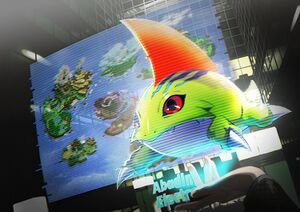Digimon (species)
- For the intellectual property, see Digimon (franchise).
| |||||||
Digimon (デジモン, Dejimon), short for Digital Monster (デジタルモンスター, Dejitaru Monsutā), are mysterious lifeforms that are the main focus of the eponymous Digimon franchise. The vast majority of Digimon reside within the Digital World, a region of pseudo-cyberspace that was created on the Network, and originated from the Net Ocean, the birthplace of life within the Digital World. There are many different species of Digimon, some of which have their own subspecies, as well as unconfirmed and new generations that have yet to be revealed.
Digimon have been depicted in many different continuities, but some of the settings have differed slightly in each work. That is because interpretations of Digimon differ from creator to creator. For instance, in Digimon Adventure, Digimon are depicted as creatures that have existed from ancient times, and they are half bodies of “Spirits” that have bonds with humans. On the other hand, in LCD games Digital Monster and Digimon Tamers, Digimon are distinctive entities that self-evolve, and are seen as AI programs in the Digital World created by humans.
In the setting of Digimon Survive, due to existing without a connection to digital data, Digimon are instead referred to by humans as Kemonogami, while they have no name for themselves. However, a year after the ending of the Moral and Truth routes, their world is sustained through the belief created in the internet to replace their previous religion, thus through digital data, which causes them to be rechristened by Minase Akiharu as Digital Monsters, or Digimon for short, and their previously-unnamed world as the Digital World.
Origins[edit]
One day, a virus possessing artificial intelligence spread onto computers throughout the world. This virus evolved in a way similar to living organisms, changing its appearance and nature on the Network, becoming the "digital lifeforms" that came to be known as "Digital Monsters", which were first discovered on there in 1997. A scientist interested in this gave the virus, which was only a program, a skeleton called wireframe, and a skin called texture. Thus the Digimon were born as digital creatures with graphics.
Characteristics[edit]
Evolution[edit]
- See Evolution
Digimon evolve with varying conditions. Methods generally being either age, collecting data, winning battles, or drawing energy off a human. Digimon have six "natural" stages of evolution, as well as others obtained through artificial help. Due to the influence of the Dark Area, the evolutionary trees of any Digimon have been altered, enabling them to evolve into many different forms.
While the anime generally presents Digimon as having conceptually "matching" evolution lines, in other aspects of the franchise, Digimon also evolve depending on how they're raised - including what time they're awake, how much they've fought, how much they've trained, how much they've eaten, and other factors. An Agumon who has been raised properly will evolve into the powerful Greymon, while one who has been starved to death will evolve into the weak and disgusting Numemon. Evolution can be temporary or permanent depending on the circumstances. Generally in the anime, Digimon evolve for a short period of time before reverting to smaller, cuter forms. In the games, Digimon usually retain their larger forms after evolving.
Nomenclature[edit]
Digicore[edit]
- Main article: Digicore
A Digicore is a program said to be found at the center of a Digimon's body.
Gender[edit]
Digimon don´t have physical sexual organs, as they are made of data, they reproduce not through sexual reproduction but through a universal system of data recycling, copying/pasting, and data merging. Even though these words are oftentimes used as synonyms, gender and sex aren't the same. Gender being something more psychological, how one identifies and acts, they do have physical representation of male/female archetypes as of secondary sex characteristics such as Lady Devimon or Angemon.
The creators of the games and anime have said that many Digimon may follow a male or female archetype.
In Digimon Championship it is stated "Digimon are not differentiated between male and female, and do not mate". In Digimon Tamers, Renamon clearly says "Digimon don't have sex/gender", the word Seibetsu (性別) means "gender" or "sex", but in this context, this could only mean "sex" , not "gender".
Digimon of the same species can act as female, male or other. As one example, the Piyomon from Adventure is identified as female, while the one from Savers is identified as male. They have different evolutionary routes (Adventure's evolving to Birdramon, and Savers' evolving to Aquilamon) but both of them evolve into Garudamon, a Digimon with masculine characteristics. As another example, in Digimon World 4 there is an Ofanimon that referred to himself as male.
Another example is the Renamon from Tamers who self-identified as genderless in the beginning of the series, and later on, as female. Chiaki J. Konaka (Digimon Tamers' screenwriter) stated "Eventually, Renamon would become Sakuyamon, a very feminine digimon. I thought that I would start Renamon out as a "genderless" digimon, and have that be a large part of its personality." On the other hand, the Renamon from Digimon Savers: Another Mission is treated as male, this is so even when he evolves into forms with female secondary sex characteristics like Lilithmon.
In the anime, Jijimon and Babamon state they are married. This could happen as in the Digimon world, Digimon can live and behave like couples even so they do not have sexual differences.
